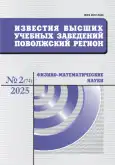Magnetoplasmonic effects at the diffraction of terahertz waves on magnetically biased graphene metasurfaces
- Authors: Makeeva G.S.1, Nikitin M.S.1
-
Affiliations:
- Penza State University
- Issue: No 2 (2025)
- Pages: 116-133
- Section: PHYSICS
- URL: https://journal-vniispk.ru/2072-3040/article/view/316352
- DOI: https://doi.org/10.21685/2072-3040-2025-2-9
- ID: 316352
Cite item
Full Text
Abstract
Background. The purpose of this work is a numerical study of the features of magnetoplasmonic effects arising from the diffraction of THz waves on graphene metasurfaces in external magnetic fields. Materials and methods. The advantage of graphene over conventional plasmonic materials for use in plasmonic and magneto-optical devices is the high sensitivity of surface magnetoplasmon-polaritons to external magnetic fields, since the cyclotron frequency is comparable to the plasmonic frequency in the THz and far IR ranges. A numerical study of magnetoplasmonic resonances of graphene metasurfaces depending on the induction of an external magnetic field and modeling of 3D e-Field scattering patterns on an element of a graphene metasurface (rectangular graphene nanoribbon) was carried out using the CST Microwave Studio program. To solve the electrodynamic diffraction problem using MWS CST, a method was chosen to analyze a graphene metasurface (an infinite periodic 2D structure) by applying periodicity conditions that reduce the problem for an infinite structure to the analysis of one period. Results. The results of modeling the 3D e-Field scattering diagram on an element of a magnetically biased graphene metasurface (a rectangular graphene nanoribbon) of an incident TEM-wave of p- and s-polarization for the vertical and horizontal components of the diffracted field at magnetoplasmon resonance frequencies in the THz range. An analysis of magnetoplasmonic effects was performed based on the calculation of the ratio of components of the diffracted field and the axial ratio at the points of cross-section (φ=0˚) of the main lobe of the 3D e-Field scattering diagrams at normal incidence of a TEM-wave of p- and s-polarization. Conclusions. From the results of the numerical study of the characteristics of the magnetically biased graphene metasurfaces it follows that magnetoplasmonic effects are observed at resonant frequencies, i.e. the appearance of another component of the diffracted field, orthogonal to the exciting one, as well as the magneto-optical effects of rotation of the plane of polarization of the transmitted wave (Faraday effect), rotation of the plane of polarization and the appearance of ellipticity of a linearly polarized wave during reflection of a linearly polarized wave from the graphene surface (magneto-optical Kerr effect), depending on the magnitude of the external magnetic field.
About the authors
Galina S. Makeeva
Penza State University
Author for correspondence.
Email: radiotech@pnzgu.ru
Doctor of physical and mathematical sciences, professor, professor of the sub-department of radioengineering and radioelectronic systems
(40 Krasnaya street, Penza, Russia)Mikhail S. Nikitin
Penza State University
Email: radiotech@pnzgu.ru
Student
(40 Krasnaya street, Penza, Russia)References
- Dapolito M., Tsuneto M., Zheng, W. et al. Infrared nano-imaging of Dirac magnetoexcitons in graphene. Nat. Nanotechnol. 2023;18:1409–1415. doi: 10.1038/s41565-023- 01488-y
- Gusynin V.P., Sharapov S.G., Carbotte J.P. Magneto-optical conductivity in graphene. Journal of Physics: Condensed Matter. 2007;19:026222.
- Crassee I., Levallois J., Walter A. et al. Giant Faraday rotation in single- and multilayer graphene. Nature Phys. 2011;7:48–51. doi: 10.1038/nphys1816
- Goerbig M.O. Electronic properties of graphene in a strong magnetic field. Reviews of Modern Physics. 2011;83:1193.
- Kuz'min D.A. Magneto-optical and plasmonic effects in graphene-based nanostructures. DSc dissertation. Chelyabinsk, 2022. (In Russ.)
- Ningning Wang, Linhui Ding, Weihua Wang. Chemical potential and magnetic field effects on graphene magnetoplasmons. Physical Review B. 2023;108(8):085406‒085415.
- Poumirol J.M., Liu P., Slipchenko T. et al. Electrically controlled terahertz magnetooptical phenomena in continuous and patterned graphene. Nature Communications. 2017;8:14626. doi: 10.1038/ncomms14626
- Ben Rhouma M., Guizal B., Bonnet P. et al. Semi-analytical model for the analysis of a magnetically biased 1D subwavelength graphene-strip-grating. Opt. Continuum. 2022;1:1144‒1156.
- Amanatiadis S.A., Ohtani T., Kanai Y. et al. Tuning of magnetosplamon coupling between graphene scatterers for the optimal design of adjustable metasurfaces. AIP Advances. 2024;14:025225. doi: 10.1063/9.0000808
- Maha Benrhouma, Kofi Sényo Edee, Brahim Guizal. Modeling the Excitation of Graphene Magnetoplasmons in Periodic Grating of Magnetostatic Biased Graphene Ribbons. PhotonIcs & Electromagnetics Research Symposium (PIERS), PIERS Academy. Prague, Czech Republic, 2023⟨hal-04172452⟩.
- Chamanara N., Caloz C. Graphene magnetoplasmonic principles, structures and devices. 2015 9th European Conference on Antennas and Propagation (EuCAP). Lisbon, Portugal, 2015:1‒2.
- Falkovsky L.A. Quantum magneto-optics of graphite with trigonal warping. Physical Review B. 2011;84(11):115414.
- CST Microwave Studio. 2023. Available at: https://www.3ds.com/products/simulia
- Kurushin A.A. Shkola proektirovaniya SVCh ustroystv v CST STUDIO = School of microwave design in CST STUDIO. Moscow, 2016:433. (In Russ.)
- Gomez-Diaz J.S., Alù A. Magnetically-biased graphene-based hyperbolic metasurfaces. 2016 IEEE International Symposium on Antennas and Propagation (APSURSI). Fajardo, PR, USA, 2016:359‒360. doi: 10.1109/APS.2016.7695888
- Sounas D.L., Caloz C. Edge surface modes in magnetically biased chemically doped graphene strips. Applied Physics Letters. 2011;99(23):231902.
Supplementary files


























